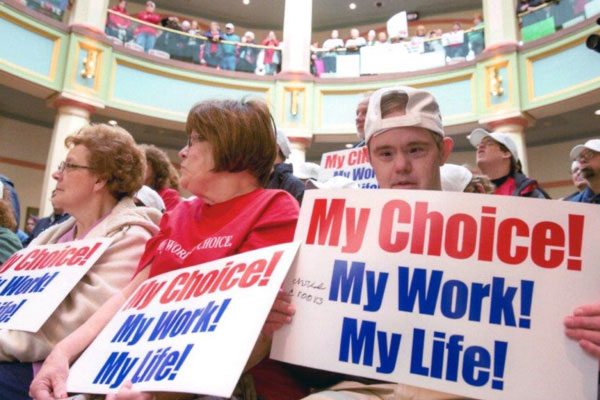
October 4, 2017; Our Town Johnstown (Daily American)
The trope is now almost torturously familiar: the “sheltered workshop” that pays employees with disabilities a subminimum wage while paying execs generously, hiring family members into well-paid positions, and doing big business with board members. NPQ has seen this same cookie-cutter pattern in Maine and Nebraska.
On Tuesday, we covered the story of one Pennsylvania Goodwill that has declared itself out of the sheltered workshop model. But, as we said then, there are still another hundred such programs in the state. This is the story of one of those that remain—and it also fits the model described above to such a tee that we have to wonder if there is a handbook somewhere.
Before we begin, we would like to mention two things. First, the high rates of pay at nonprofits are positively correlated to high liquidity. (You can read more about that in “What Drives Nonprofit Executive Compensation,” an article from the Summer 2011 edition of the Nonprofit Quarterly.) Thus, it is—at least on the surface—in the best interests of executives to keep revenues high and costs low, including payroll costs. Of course, we all must do some form of that, but not to the exclusion of other critical considerations.
Second, some familiar ways around the requirement that nonprofit assets not be converted to personal enrichment is by hiking up salaries and doing business with related entities.
At the Cambria County Association for the Blind and Handicapped, the president has averaged more than $500,000 in annual compensation over the past five-year period to run the $15 million corporation with tax exempt status. Its assets exceed $50 million according to its 2014–15 Form 990, and Bruce Siwy, the reporter for Our Town Johnstown, asks, “Are these kinds of nonprofits serving the disabled, or are the disabled serving these nonprofits?”
Good years for this relatively small nonprofit can be really good; in 2013, with its ultra-cheap labor costs, the organization netted a cool $5 million.
Here is how it works: The 151 sheltered workshop employees at the organization received approximately $2 million in wages and benefits in 2015, or approximately $13,245 per worker. Of that $2 million, $1.9 million was subsidized in the form of Medicaid and Medical Assistance Program subsidies, leaving $81,000 in labor costs to be footed by the organization itself. This means that the sheltered workshop earned revenue pays each of these workers around $536 a year.
Again, to reemphasize, the president of the nonprofit makes approximately 1,000 times that.
Sign up for our free newsletters
Subscribe to NPQ's newsletters to have our top stories delivered directly to your inbox.
By signing up, you agree to our privacy policy and terms of use, and to receive messages from NPQ and our partners.
“We’ve always been sort of a quiet place,” said Tara Bosserman, daughter of Richard Bosserman, the well-paid president. “Always” in this case dates back to the 1920s, when the agency was established and attitudes about the capabilities and rights of those with disabilities were very different.
In the 1970s, according to the nonprofit’s brochure, he “aggressively pursued institutional contracts to supply hospitals and government agencies with everything from food service kits to pillowcases and mops.” The Ebensburg division opened in 1974 with a new emphasis on creating cable hooks and hangers—products now sold by the millions for use primarily in mines overseas.
“Our mining (production operation) has just really blossomed,” Tara Bosserman said, noting that employment soared from 15 to more than 400 under her father’s tenure. “As a company, we’ve been very blessed through a lot of hard work.”
There are five other execs at the agency that make more than $100,000, including Bosserman’s daughter Tara. Again, the pattern is cut from the same cloth as other, similar programs upon which we have reported, both in that regard and in that board members of the group do regular business with it, creating multiple conflicts of interest.
Reportable compensation for attorney Kevin Persio, who provides legal services, totaled $29,000 for the years 2010–11 through 2015–16. The board’s first vice chairman, Byron Custer III, an investment adviser with Wells Fargo, had reportable compensation totaling $218,000 for this same time period, according to 990 forms.
Board member John Boderocco, according to the organization’s 2013–14 Form 990, was compensated at $831,000. Boderocco says in his defense that “I think all of that would be (attributed to) architecture and engineering” services provided by the company H.F. Lenz, where he was president and which participated in a recent $12 million renovation. “None of (the money) went to me personally. All of it went to the company.”
The 990 forms note that the nonprofit had four people listed under “business transactions involving interested persons.” They are Tara Bosserman; Stephanie Smith, daughter of Richard Bosserman and salaried at $89,381; Patrick Krumenacker, son of the board member, making $38,096 annually; and Kory Hughes, “son of key employee,” receiving $96,444.
We commend the reporters who cover these stories locally, but this appears to be a nationally used business model which, though largely operating within strictly legal bounds, is well outside of current social mores.—Ruth McCambridge












